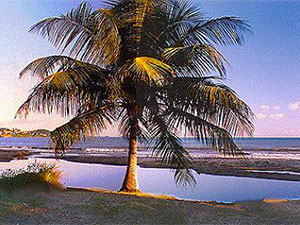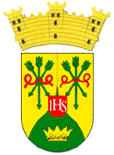Humacao, Puerto Rico
(oo-mah-KOU)
Humacao is located in the eastern coast of the island,
north of Yabucoa; south of Naguabo; east of Las Piedras; and west of Vieques Passage.
Humacao is known as "La Perla del Oriente" (pearl of
the orient) and "La Cuidad Gris" (gray city).
The city was founded on April, 1722 and became autonomous (town)
in 1793. Humacao derives its name from a local Indian chief Jumacao.
Off shore near (1 km) Humacao is an island inhabited by Rhesus monkeys once
used for scientific experiments back in the 1930s. Cayo Santiago (15.2 ha (38
acres) host one of two field stations of the Caribbean Primate Research Center
in the island. The small island contains a population of approximately 800 monkeys,
which are direct descendants of the original 409 monkeys imported from India and
released onto the island in 1938. Research policy strictly limits the number of
visitors allowed on the island at any one time, but you can cruise around it and
snorkel nearby, observing the monkeys from a distance that is safe for both you
and the animals.
Humacao's small airport is served by Vieques Air Link with a daily flight
from Vieques.
The town has light industry, including textiles, plastic products,
and castor-oil extracting. The surrounding area produces coffee,
sugarcane, rice, and tobacco.
There are many well-known "humacaeños", among them:
- Luis Rafael Sánchez
- Osiris Delgado
- Rita Moreno
- Emilio E. Huyke
- Felipe Janet
- Antonia Saez
- Juan Pena Reyes,
- Federico Acosta Velarde
- Jus Luis Rivera "Yoyo Boing"
- Lito Pena
- Lucy Fabery
- Luis Somalea Iglesias
Humacao is made up of 13 barrios (wards/districts):
- Antón Ruiz
- Buena Vista
- Candelero Abajo
- Candelero Arriba
- Cataño
- Collores
- Mabú
- Manbiche
- Mariana
- Pueblo
- Punta Santiago
- Río Abajo
- Tejas
Rivers:
Antón Ruíz, Candelero and Humacao
Restaurants
- Aji (Puerto Rican), (787) 852-6000
- A Lo Natural (Vegetarian), (787) 852-0945
- Asia Express (International), (787) 643-3908
- Bamboo (International), (787) 285-2277
- Beach Bohio (International), (787) 852-6000
- Blue Hawaii (International), (787) 852-6000
- Chez Daniel (International), (787) 852-6000
- Chili's Grill & Bar (Humacao) (American), (787) 285-0210
- Coconuts Cafe (American), (787) 850-2233
- Coco Nuts Cafe (Puerto Rican), (787) 850-2223
- Daniel Seafood (Sea Food), (787) 852-1784
- La Brochette (Sea Food/Puerto Rican), (787) 852-7173, (787) 852-6000
- Luigi's Cigar Bar & Sidewalk Cafe (Puerto Rican), (787) 850-3500
- Marie's Restaurant (Sea Food), (787) 852-5471
- Paradise Seafood (Puerto Rican/Sea Food), (787) 852-1180
- Paradise Sea Food (Sea Food), (787) 852-1180
- Plaza Steak House (Steak), (787) 850-2233
- Tocococo Restaurant (Puerto Rican), (787) 888-6000
- Tulio's Sea Food (Sea Food), (787) 850-1840
Accommodations
- Palmas del Mar Villa (Villa),
(908) 763-7054
- The Villas at Palmas del Mar (Resort),
(800) 468-3331
(939) 645-0916
Festivals and Events
- Festival Comunitario de la Iglesia Católica - December
- Festival de Bomba y Plena - April
- Festival de la Lancha Planua - June
- Festival de la Pana del Barrio Mariana - August
787-852-5326
- Fiestas de Cruz - March
- Fiestas de Reyes - January
- Fiestas Patronales Inmaculada Concepcion de Maria - December
Every year, Humacao celebrates a patron saint festival. The festivities include dances, food, parades and religious processions.
(787)852-3066
Education
There are 31 public schools in Humacao,
education is handled by the Puerto Rico Department of Education. Humacao is also home of 5 colleges and universities.
Climate
The annual precipitation is around 98 inches.
10 Day Forecast from weather.com
Symbols
The coat of arms consists of two colors, gold and green. The gold represents the sun, Humacao is located in the island were the sun rises. Green symbolizes the native Indian heritage as well as the natural tropical valley where the city is located. The shield itself represents Humacao's native and Indian name origin.
It consists of three horizontal stripes: gold that stands for Chief Jumacao's crown, red that symbolizes the Coat of Arms and the green that represents the arrows used by the Taínos.
Anthem:
Humacao, hijo de taíno bravío...
Demographics *
Population
50,896
Puerto Rico: 3,285,874
Land Area: 44.75 sq mi
Density: 1,153.60 per sq mi
Median Age: 44.5
Sex: 53% female
Economics **
Per capita income
$13,832Puerto Rico: $21,058
Median household income: $21,802
Puerto Rico: $21,058
Persons below poverty line: 39.8%
Housing, families and educational attainment *
Number of households
13,914
Housing units density:
627.9 (2013)
Persons per household: 2.88
High school grad or higher: 79.3%
Marital status: 41% married
* U.S. Census Bureau 2020 data, unless otherwise noted - Source: Quick Facts Puerto Rico.
** U.S. Census Bureau 2016-2020
Map References
Coordinates: 18.1497° N, 65.8275° W
ZIP Code: 00741, 00791, 00792
Driving Distance from San Juan: 30.8 miles
Driving Time: 1 hours, 2 minutes







